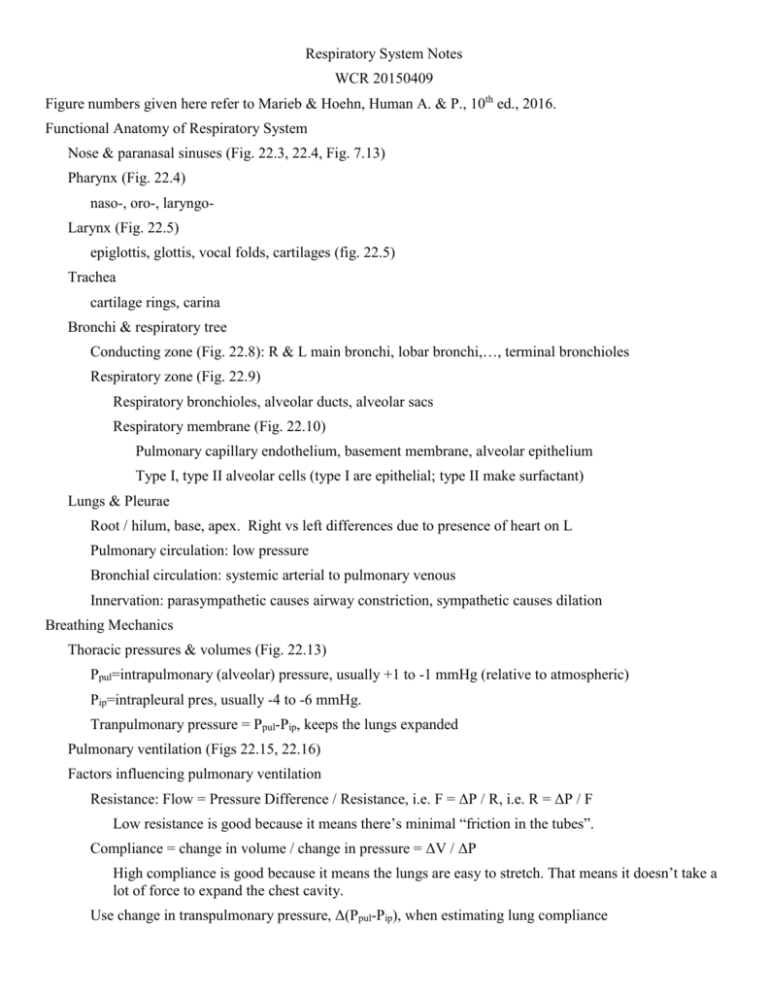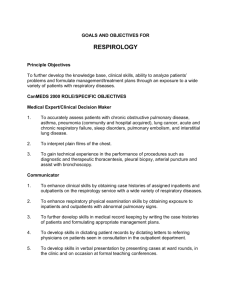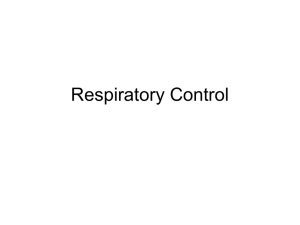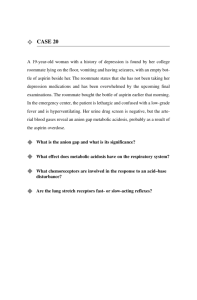respiratory_system_n..
advertisement

Respiratory System Notes WCR 20150409 Figure numbers given here refer to Marieb & Hoehn, Human A. & P., 10th ed., 2016. Functional Anatomy of Respiratory System Nose & paranasal sinuses (Fig. 22.3, 22.4, Fig. 7.13) Pharynx (Fig. 22.4) naso-, oro-, laryngoLarynx (Fig. 22.5) epiglottis, glottis, vocal folds, cartilages (fig. 22.5) Trachea cartilage rings, carina Bronchi & respiratory tree Conducting zone (Fig. 22.8): R & L main bronchi, lobar bronchi,…, terminal bronchioles Respiratory zone (Fig. 22.9) Respiratory bronchioles, alveolar ducts, alveolar sacs Respiratory membrane (Fig. 22.10) Pulmonary capillary endothelium, basement membrane, alveolar epithelium Type I, type II alveolar cells (type I are epithelial; type II make surfactant) Lungs & Pleurae Root / hilum, base, apex. Right vs left differences due to presence of heart on L Pulmonary circulation: low pressure Bronchial circulation: systemic arterial to pulmonary venous Innervation: parasympathetic causes airway constriction, sympathetic causes dilation Breathing Mechanics Thoracic pressures & volumes (Fig. 22.13) Ppul=intrapulmonary (alveolar) pressure, usually +1 to -1 mmHg (relative to atmospheric) Pip=intrapleural pres, usually -4 to -6 mmHg. Tranpulmonary pressure = Ppul-Pip, keeps the lungs expanded Pulmonary ventilation (Figs 22.15, 22.16) Factors influencing pulmonary ventilation Resistance: Flow = Pressure Difference / Resistance, i.e. F = ΔP / R, i.e. R = ΔP / F Low resistance is good because it means there’s minimal “friction in the tubes”. Compliance = change in volume / change in pressure = ΔV / ΔP High compliance is good because it means the lungs are easy to stretch. That means it doesn’t take a lot of force to expand the chest cavity. Use change in transpulmonary pressure, Δ(Ppul-Pip), when estimating lung compliance Surface tension; surfactant Obstructive (high resistance) vs. restrictive (low compliance) lung disease Respiratory volumes, pulmonary function testing See fig 22.18 Tidal volume (VT): Volume of air exhaled in a single normal breath. Approximately 500 ml at rest. Anatomical dead space (VD): Volume of air in the nose, trachea, and bronchioles, i.e. the regions which do not participate in gas exchange. Approximately 150 ml. Breathing frequency (f): Number of breaths per minute. Also abbreviated RR (respiratory rate). Vital capacity (VC) (sometimes called Forced Vital Capacity, FVC): The maximal amount of air exhaled after a maximal inspiration. Approximately 4000-5000 ml. Normal values depend on gender, race, age, and size. Expired ventilation (also referred to as minute ventilation or minute volume) (𝑉𝐸̇ ): Total volume of air expired per minute. Sometimes called minute ventilation. The dot over V indicates this is a time derivative, or a measure of volume per unit time (ml/min). 𝑉𝐸̇ = 𝑓 ∙ 𝑉𝑇 Alveolar ventilation rate (𝑉𝐴̇ ): Volume of fresh air that reaches the alveoli every minute. 𝑉𝐴̇ = 𝑓 ∙ (𝑉𝑇 − 𝑉𝐷 ) Forced expired volume in one second (FEV1): The amount of air exhaled in the first second of a maximal exhalation. Normally 75-85% of VC. Non-respiratory air movements: cough, speech, sneeze, etc Gas Exchange between Lungs, Blood, & Tissues Properties of gases Boyle’s law, partial pressures, Henry’s law Composition of alveolar gas Gas partial pressures around the system (Fig 22.19) External respiration Movement of gases between alveolar air and blood. Occurs in pulmonary capillaries. Passive, i.e. gases move down their concentration gradients, from high partial pressure to low partial pressure. Understand ventilation-perfusion coupling (Fig. 22.21). Internal respiration Movement of gases between blood and peripheral tissues. Occurs in systemic capillaries. Passive, i.e. gases move down their concentration gradients, from high partial pressure to low partial pressure. Transport of Respiratory Gases in Blood Oxygen Oxygen is poorly soluble in water or plasma, so we need hemoglobin (Hb) to help transport enough O2 to meet the body’s need. About 98% of O2 carried by Hb. Understand “Focus Figure 22.1”: oxygen-hemoglobin dissociation curves (could be called oxyhemoglobin saturation curves). One hemoglobin molecule (Hb) can bind up to 4 O2 molecules. Oxygen saturation (O2 sat) of systemic arterial blood is near 100% in normal healthy person at sea level. This means all 4 oxygen binding sites are very likely to be “occupied” by O2. In systemic venous blood, typical O2 sat is about 75%. This means about 3 out of 4 oxygen binding sites are occupied by O2. Bohr effect: Increased acidity (i.e. lower pH) and increased PCO2 cause oxy-hemoglobin saturation curve to shift down and to right (shown in Fig 22.22b). This rightward shift of the curve means O2 is less likely to stick to Hb. This promotes O2 “unloading” from Hb. In metabolically active peripheral tissues, such as exercising muscle, PCO2 will be higher and pH will be lower. This causes the rightward shift of the oxyhemoglobin dissociation curve, which promotes O2 unloading in the tissues where O2 is needed most. That’s a good thing. Hypoxia = hypo-oxia = inadequate oxygen delivery to tissues. Causes include anemia, ischemia, carbon monoxide poisoning, high altitude (since high altitude causes low inspired PO2), various respiratory diseases (since respiratory diseases can interfere with gas exchange in the lungs). Carbon dioxide CO2 much more soluble in water and blood plasma than O2. CO2 in systemic venous blood is about 10% dissolved CO2, 20% attached to Hb, and 70% in the form of bicarbonate ions (HCO3-). CO2 + H2O ⇌ H2CO3 ⇌ H+ + HCO3Chemical equation above suggests that if CO2 rises, H+ will rise (since there always plenty of H2o around). This means there is a connection between CO2 and acidity in blood. More CO2 => more acidic (i.e. lower pH). This also means the respiratory system can and does help control acidity. It also means respiratory system problems can cause acid-base imbalances. To reduce acidity, reduce the CO2 in blood, i.e. increase ventilation, to blow off more CO2. Control of Respiration Neural Control: Figures 22.24, 22.25 Medulla Ventral respiratory group neurons (VRG) give rise to phrenic and external intercostal motor neurons. i.e. the neurons that drive inspiration. Dorsal respiratory group neurons (DRG) receive and process peripheral receptor inputs (stretch receptors, chemoreceptors) and communicate with and influence activity of VRG neurons. Pons Pontine respiratory group neurons get input from many sources that influence respiration including cerebral cortex, hypothalamus, central (i.e. brain) and peripheral chemoreceptors, pulmonary stretch receptors, etc. The pontine neurons process this info and communicate with and influence the activity of the DRG and VRG Factors influencing rate and depth of breathing (rate = breaths per minute, depth = tidal volume) Chemical factors (Fig 22.26, 22.27) PCO2: normal arterial PCO2 = PaCO2 = 40 mmHg. Detected by central chemoreceptors (in brain) and peripheral chemoreceptors. Hypercapnia = elevated PaCO2 (>=45 mmHg). Central & peripheral chemoreceptors activated by hypercapnia cause reflex increase in ventilation (both rate & depth of breathing) to help get rid of CO2. Hyperventilation (which may be due to anxiety) = excessive ventilation, which causes PaCO2 to get too low. This is not good because of the connection between CO2 and pH: too low CO2 means blood gets too alkaline, i.e. arterial pH > 7.45. PO2, pH: Normal systemic arterial PO2 = PaO2 = 80-100 mmHg. Normal systemic arterial pH = 7.357.45. Peripheral chemoreceptors (Fig 22.26; in aortic arch and at carotid bifurcation, like arterial baroreceptors) are activated by low Pa02 and low pH. When peripheral chemoreceptors send more impulses to brain respiratory control centers (DRG, pons), it causes increase in rate & depth of breathing. These chemical control systems are examples of negative feedback control systems which function to maintain homeostasis. Higher brain centers Hypothalamus Cerebral cortex Pulmonary irritant reflexes Pulmonary inflation reflexes (mediated by pulmonary stretch receptors) Respiratory Adjustments Exercise High altitude Homeostatic Imbalances of Respiratory System COPD O for obstructive = elevated airway resistance Emphysema Alveolar wall destruction leads to decreased surface area of respiratory membrane Air trapping in lungs => “barrel chest” Chronic bronchitis Asthma Elevated airway resistance due to narrowed airways due to inflammation of airway wall tissue Tuberculosis Lung cancer Elevated PCO2, decreased PO2 are symptoms of many lung diseases.










